
Inspired by the Hawaiian Spam Musubi and made with pantry staples, this Spam Onigiri recipe makes for a quick meal that's satisfying, easy to make, and portable. With a crispy slab of pan-fried Spam and a fluffy omelette folded between layers of rice and nori, you probably already have the simple ingredients on hand. Whether you're looking for a light lunch or a satisfying grab-and-go snack, this Japanese rice sandwich is an easy form factor that can be adapted with a wide variety of fillings.
Why This Recipe Works
- Pan-frying the Spam crisps up the edges, giving it a nice texture while reducing the "canned meat" flavor that luncheon meat tends to have.
- Adding an egg omelette helps balance the saltiness of the Spam while adding more protein to this easy onigiri sandwich.
- Sprinkling the rice with salt seasons it, so you don't have any bland bites. It also helps to preserve it if you take this Spam and egg onigiri on the go.
- Constructing the onigiri like a sandwich gives a better ratio of filling to rice, and wrapping it in nori ensures it doesn't stick to your fingers.
Ingredients
- White Rice - Japanese short-grain rice (a.k.a. "sushi rice") has just the right amount of stickiness to hold the onigiri together while maintaining a soft, tender texture, and its mild sweetness balances out the savory flavors of the fillings. If you can't find it medium-grain rice such as Calrose rice will work. However, you'll want to avoid long-grain types of rice like jasmine or basmati rice, as these will not hold together.
- Spam - The star of this Okinawan onigiri is loaded with umami and gets beautifully crisp when pan-fried. You can experiment with other luncheon meat or even substitute other proteins such as tuna mayo, salmon, kakuni, or chicken teriyaki, or pan-fried tofu for a vegetarian version.
- Nori - Nori sheets are made with a type of seaweed that's been dried into sheets before being roasted. The delicate umami and stunning color provide a beautiful contrast to the rice and fillings, but it's also a functional ingredient that holds the rice together while keeping your hands clean.
- Eggs - The omelette layer in this spam onigiri recipe balances the saltiness of the Spam with its mild flavor and creamy texture while boosting the protein content of this hand-held meal.
- Salt - While Spam is quite salty, the savory taste doesn't meld with the other ingredients until you start chewing. That's why it's essential to season the rice separately when making delicious onigiri. The salt will also help preserve the rice when you pack it for lunch.
- Toasted Sesame Seeds - Brings a nutty flavor and poppy crunch that elevates my spam onigiri recipe with additional depth. Black or white sesame seeds work equally well; you can experiment with other textural elements, such as sprinkling on furikake rice seasoning.
- Green Shiso - These aromatic leaves add a bright, herbaceous note that cuts through the richness of the Spam and egg. If you can't find shiso, fresh basil, Korean perilla leaves, or chopped green onions make excellent alternatives.

How to Make Spam Onigiri
Good onigiri starts with good steamed rice. I usually use a rice cooker, but I've also got a stove-top rice recipe you can check out if you don't have one. While your rice is cooking, cut the nori sheets in half lengthwise with a sharp knife or scissors.
Crack the eggs into a mixing bowl and remove the chalaza (those white stringy bits attached to the yolk) - this step might seem fussy, but it ensures your egg will be smooth and uniform. Beat the eggs until the yolks and whites are completely combined.
For the Spam, start by trimming off the rounded edges; this makes it easier to portion. Then, you want to slice it vertically into four even slices. Heat a non-stick pan over medium heat and fry the Spam slices in a touch of oil until they're golden brown and crispy on both sides. I usually use a tamagoyaki pan because it makes it easier to shape the egg in the next step. Once cooked, transfer the caramelized Spam to a plate and wipe out the excess oil from the pan with a paper towel.
Turn down the heat to low and pour half the beaten egg mixture into the pan. Briskly scramble the egg with chopsticks for the first few seconds to help it cook through faster, but stop stirring before it's fully set so the liquid egg can run into any gaps and form a single sheet. Once the omelette is mostly set but still slightly glossy on top, cut it in half and fold it to match the size of your Spam slices. Repeat with the remaining egg.
To assemble your spam musubi onigiri, spread a large sheet of plastic wrap on your work surface and place a nori sheet on it with the shiny surface facing down. Spread an even layer of warm rice over the nori using a rice paddle or the back of a spoon, spreading the grains of rice gently toward the edges without smashing them.
Season the rice with a pinch of salt and sprinkle with toasted sesame seeds. Add your shiso leaves, positioning them so they'll peek out attractively from the corners. Layer on your crispy Spam and a sheet of egg, then use the plastic wrap to help you fold everything into a neat sandwich shape. Wrap the plastic around the onigiri tightly to set its shape. This technique ensures the filling stays snugly inside, and the nori adheres to the rice for easy handling. For fluffier rice you can make this Japanese rice sandwich without the plastic wrap but it won't hold together as well. Repeat the process for the remaining ingredients to make three more Spam and egg onigiri.
Serve it With
Spam onigiri is a self-contained meal, but if you plan to pack it into a bento box and want some other items, here's what I would do. A mayonnaise-based salad like Kani Salad, Hawaiian Macaroni Salad, or Japanese Potato Salad is a great way to add a creamy contrast to your Spam rice balls. If you want something more refreshing, try my Wasabi Cucumber Pickles or my Smashed Cucumber Salad. For dessert, a bag of Sata Andagi (Okinawan brown sugar donuts) make for the perfect sweet end to this picnic lunch.
And be sure to check out this other iconic Okinawan creation: Taco Rice. It's a quick and easy fusion dish that mashes up TexMex tacos with Japanese donburi for an out-of-this-world experience.
📖 Recipe


Units
Ingredients
- 600 grams cooked Japanese short-grain rice (click the link for my recipe)
- 2 full sheets nori
- 4 large eggs
- 1 can SPAM
- 1 teaspoon vegetable oil
- salt (to taste)
- 2 teaspoons toasted sesame seeds
- 8 green shiso leaves (or other herbs like basil or chives)
Instructions
Prep
- Cook 2 rice cooker cups of rice in a rice cooker or follow my recipe for making Japanese rice. You'll need 600 grams cooked Japanese short-grain rice.
- Cut 2 full sheets nori in half lengthwise (from side to side with the long edge facing you).

- Break 4 large eggs into a bowl and remove the chalaza (the white membranes connected to the yolks) using chopsticks. Beat the eggs until the yolks and whites are evenly combined, and the mixture is uniform in color.

- Trim the rounded ends off the sides of 1 can SPAM and then slice it vertically into 4 even slices.

Cook
- Heat the 1 teaspoon vegetable oil in a non-stick pan over medium heat until it's shimmering, and then add the slices of spam. Fry on one side until they're golden brown and crisp and then flip and brown the other side (about 2 minutes per side) then transfer to a plate. You may need to do this in 2 batches.

- Turn down the heat to low and wipe out all of the excess oil from the pan. Add half of the egg mixture. Scramble the eggs for a few seconds with chopsticks, but stop stirring before there's not enough liquid egg to run into the gaps you create.

- Let the egg cook most of the way through, and then use a spatula to cut the omelette in half. If you are using a tamagoyaki pan, fold each sheet of egg in half to make it about the size of your Spam. If you are using a different pan, fold the egg as many times as needed to make it roughly the shape and size of the Spam. Transfer the egg to the plate with the spam and repeat with the remaining egg.

Assembly
- Lay down a large sheet of plastic wrap and add a sheet of nori with the shiny surface facing down. Spread about 150 grams of cooked rice evenly over the surface of the nori using a rice paddle or spatula. Sprinkle the rice evenly with a pinch of salt and a pinch of toasted sesame seeds.

- Add 2 shiso leaves to one side of the rice, with the leaves sticking out a bit from the corners. Top with a slice of Spam and a sheet of egg.

- Use the plastic wrap to flip the rice and nori on one side up and over the fillings to make a sandwich, and then wrap the plastic around your spam onigiri to set its shape. Repeat the Assembly steps for the remaining onigiri.

Nutrition Facts
FAQs
In Japan, the words omusubi and onigiri are interchangeable, but "spam musubi" usually refers to the Hawaiian style of making it with a block of rice topped with a slab of Spam. Meanwhile, the spam onigiri from Okinawa is made more like a sandwich with Spam (and sometimes egg) folded between a layer of rice and nori.
Onigiri is often translated as "Japanese rice balls," but it's a family of rice dishes formed into various shapes to make it easy to eat by hand. A triangle shape is the most common, but shaping them like a sandwich leaves more room for fillings, and you don't need an onigiri mold to make it.

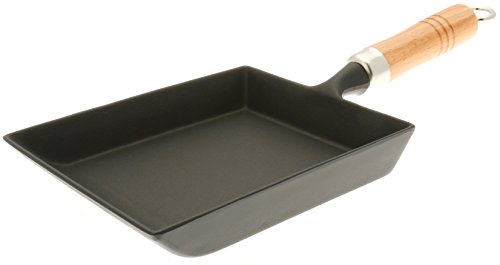

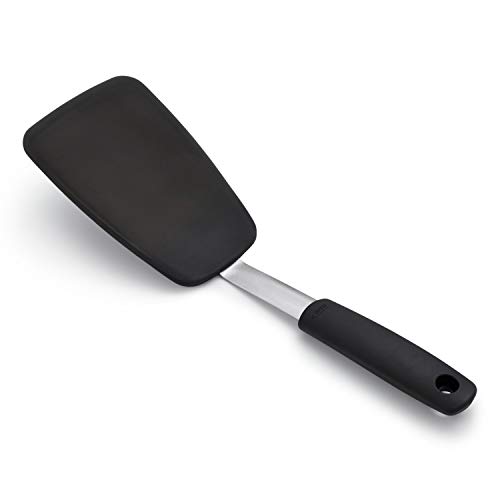
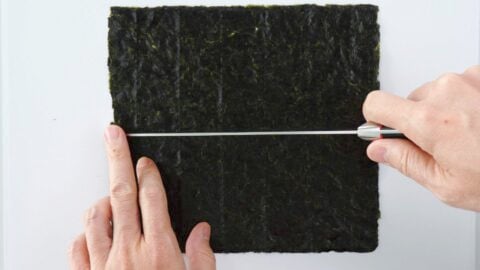
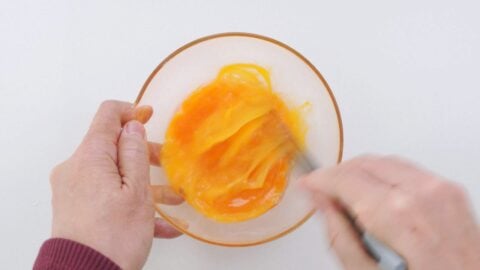

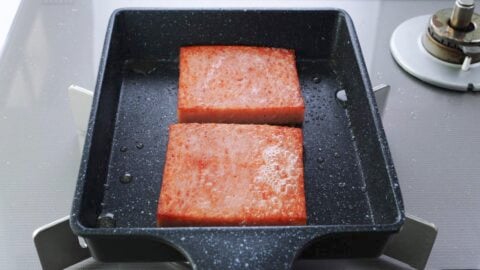

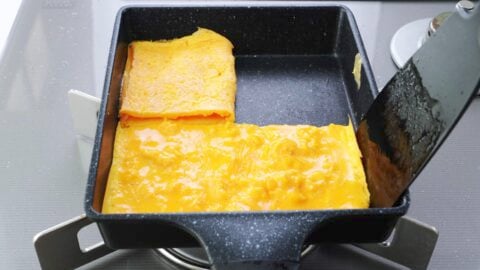
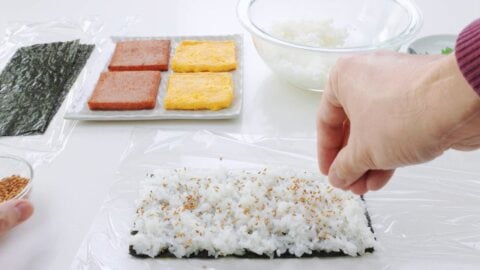
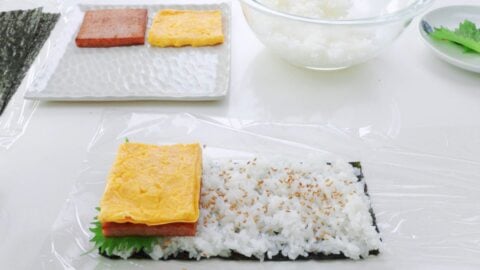
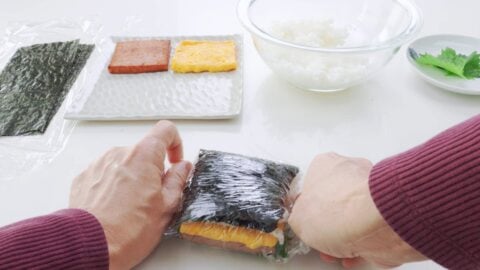
Kamila says
These look great! if I pack them for the kids in the morning, will they be ok unrefrigerated until lunch time?
thank you,
Kamila
Marc Matsumoto says
Thanks Kamila! It's kinda hard to answer this question since food spoiling is affected by a lot of factors including temperature, humidity, how the food was handled, how it's packaged, etc. If you want to be safe, prepared food should always be refrigerated if it's not being eaten right away. That being said, people here in Japan roll the dice and take onigiri with them for lunch at room temperature.0
K Stroup says
We devoured these as fast as I made them! But I'm sure they'd be perfect to pack into a bento or lunchbox. Served them with a bowl of miso soup. Just right for a Sunday afternoon.
Marc Matsumoto says
So happy you guys enjoyed these! Thanks for reporting back!